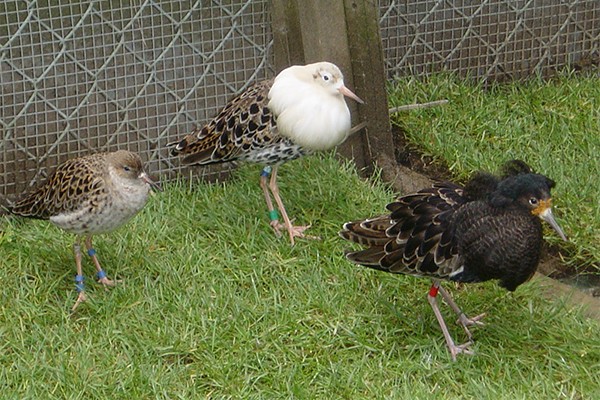
Three Ruff male types. Photo: Susan McRae
A single gene that regulates testosterone levels in a "crazy" species of shore bird controls the development of three wildly different types of males, an international study involving researchers at Simon Fraser University has found.
Ruffs have long fascinated scientists for their three types of males, known as morphs, that differ radically from each other in appearance and mating behaviours.
A new study published on the cover of the journal Science this month has discovered that these morphs are produced by a super enzyme (HSD17B2) in the blood of the birds that's able to regulate testosterone levels in males and rapidly break down the hormone normally associated with male dominance and aggression.
"The species is crazy, with three kinds of outlandish looking and behaving males," says David Lank, a biologist at SFU who has studied ruffs for 40 years and whose team first discovered the testosterone differences between the morphs. "This paper explains a lot about the genetic and physiological process that control the development of the three types."
Most male ruffs are known as "independents" and are known for their striking, darker breeding plumage and aggressive defense of small mating areas to impress females, who provide all parental care. "Satellites" are smaller and have lighter coloured plumages, and form alliances with independents to co-display to females. Although they cooperate to some extent, each male is still attempting to mate with as many females as possible.
A third morph, "faeders", take an ingenious approach. It forgoes plumage and display behaviour altogether, thereby disguising themselves as females, which lets them sneak unnoticed into mating arenas.
For the satellites and faeders, whose strategies aren't based on aggressive behaviour, too much testosterone is counterproductive. Earlier studies had shown that both types of males have significantly lower testosterone levels in their blood.
The new paper identifies the exact gene that produces the super enzyme controlling testosterone levels throughout the body, except in the testes. Testosterone is still needed there for males to produce competitive sperm.
Lank says ruffs are unique in having three male morphs and showing chromosomal inversions, but the hormonal mechanics apply generally to all vertebrates, including humans.
He says a special form of the steroid hormone gene identified in the paper might one day have therapeutic uses for humans, though more study is required.
"HSD17B2 is three to four times as efficient in converting testosterone in androstenedione," he says. "This raises the possibility of treating people with some hyper-testosterone disorders with this form of enzyme, or a synthetic enzyme designed based on its structure."
The study was led by researchers at Germany's Max Planck Institute for Biological Intelligence, in collaborating with scientists at SFU, FU Berlin, University of Vienna, and Helmholtz Munich.
AVAILABLE SFU EXPERTS
DAVID LANK, adjunct professor, biological sciences






